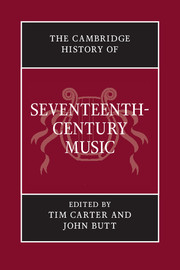Book contents
- Frontmatter
- 1 Renaissance, Mannerism, Baroque
- 2 The seventeenth-century musical ‘work’
- 3 Music in the market-place
- 4 Music in new worlds
- 5 Music and the arts
- 6 Music and the sciences
- 7 The search for musical meaning
- 8 Power and display: music in court theatre
- 9 Mask and illusion: Italian opera after 1637
- 10 The Church Triumphant: music in the liturgy
- 11 Devotion, piety and commemoration: sacred songs and oratorios
- 12 Image and eloquence: secular song
- 13 Fantasy and craft: the solo instrumentalist
- 14 Form and gesture: canzona, sonata and concerto
- Appendix I Chronology
- Appendix II Places and institutions
- Appendix III Personalia
- Index
- References
12 - Image and eloquence: secular song
Published online by Cambridge University Press: 28 March 2008
- Frontmatter
- 1 Renaissance, Mannerism, Baroque
- 2 The seventeenth-century musical ‘work’
- 3 Music in the market-place
- 4 Music in new worlds
- 5 Music and the arts
- 6 Music and the sciences
- 7 The search for musical meaning
- 8 Power and display: music in court theatre
- 9 Mask and illusion: Italian opera after 1637
- 10 The Church Triumphant: music in the liturgy
- 11 Devotion, piety and commemoration: sacred songs and oratorios
- 12 Image and eloquence: secular song
- 13 Fantasy and craft: the solo instrumentalist
- 14 Form and gesture: canzona, sonata and concerto
- Appendix I Chronology
- Appendix II Places and institutions
- Appendix III Personalia
- Index
- References
Summary
In ceremonies such as a Mass of thanksgiving or the performance of a royal birthday ode, the music embraces the aims of the event as a whole, whether trumpets are playing simple tattoos or the best soprano warbles the verse of the court poet. Such public displays could proclaim and reinforce political and social hierarchies in many ways, at the very least by confirming the prestige of the employer–patrons of those who made the music. Yet even in the largest cities of Europe, such public performances would have been fairly rare occasions. What of more ordinary and personal music-making: the servant singing as she washes linens, or the Dutch merchant’s wife at her keyboard? Samuel Pepys singing Carissimi to his guitar, or castratos singing love-duets in a palatial but private performance? What we call secular vocal music comes from all social classes and includes traditional songs, popular songs, and music to the newest poetry; music written down as well as music learnt only by ear; tunes sung to oneself, sung with friends or accompanied by a professional instrumental ensemble.
General surveys have tended not to explore such diversity in seventeenth-century music-making and have typically been content to open the new century by calling attention to a shift from singing in parts to accompanied solo song. For the period roughly between 1580 and 1620 one finds comparisons drawn between the ‘old’ unaccompanied polyphonic madrigal (and its presumed emphasis on counterpoint) on the one hand, and on the other, the solo madrigal with continuo accompaniment (and its presumed homophony).
- Type
- Chapter
- Information
- The Cambridge History of Seventeenth-Century Music , pp. 378 - 425Publisher: Cambridge University PressPrint publication year: 2005
References
- 1
- Cited by



